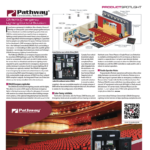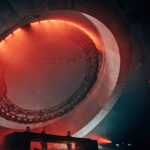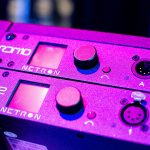In one of my many past lives, as a systems integrator, I specified a number of Zero 88 Frog consoles, mostly the Fat Frog, which was nicely positioned for the entry market. I was surprised when Zero 88 opted to drop the Fat Frog and jump to the Leap Frog range. Rather than an entry-level board, it’s now a mid-range console with control of up to 200 automated lights. Zero 88 has kept the ease of getting started on the console, plus, if you plan to grow your system, Leap Frog does not have the limitations of Fat Frog.
The ergonomic layout and facepanel hardware will be pretty familiar to anyone coming from other Frog consoles. The real improvements are in the software and functionality. The new consoles feature two DMX universes as standard, USB show file storage, external touchscreen support, multiple onboard LCD displays and multifunctional keys. Options include a custom flight case, four DMX universe upgrade, SMPTE, MIDI, Zero 88s’ ChilliNet and remote switch upgrades. The console is easily manageable with dimensions of 4.5”H x 30”W x 22.6”D (115mm x 765mm x 575mm) and a weight of 35lb (16kg).
Three Operating Modes
The Leap Frogs offer three operating modes: a simple non-tracking mode for beginners, an advanced partial mode and a new professional mode, which offers parameter-level programming and full tracking with split times. Changes in the Leap Frog include control of up to 200 automated fixtures, which can be allocated to up to 400 groups. At this writing, v4 software is shipping in the Leap Frog 48 with a host of new features and expanded attributes. The v4 upgrade doubled the available number of each type of palettes, groups and macros, from 200 to 400. You can record up to 1,600 palettes, 400 each of color, beam, position and effect palettes. There are also 400 macros. One of the cool new features is the new Color Picker, letting you quickly choose colors for CMY or RGB fixtures. It works across fixture types — anything that has CMY or RGB values. You grab and select colors via a chromaticity diagram, which works well with a touchscreen.
With the Quick Guide you can be up and running in short order. In addition, there is a manual on CD and training DVD. Seven short videos hosted by Peter Kirkup, Zero 88 product specialist, walk you through the basics of getting started, setting levels, recording looks, patching and working with automated lights. You can find them at http://www.leapfrogdesk.com/video.php.
The console comes with dust cover, power supply, USB console light and a USB key for memory storage. The switch mode power supply will work from 100V-260V and 47-63Hz.
Since the console is designed to work without one, you don’t necessarily need a monitor, but I would recommend one. The console XGA video out has a resolution of 1024×768, so most PC monitors will work. You can also attach a touchscreen monitor via USB. At present it has been tested with 3M touchscreens. (Check with A.C.T Lighting, the North American distributor for the product line, for model compatibility before purchasing a touchscreen.)
There are two five-pin XLR outputs that default to DMX universe one and two and one DMX input. The console also has ArtNet so you can output two more universes. You can also attach a keyboard and mouse via the USB ports. The console has direct access to the fixtures and there is no numeric keypad, but you can add one via the USB ports, or you can access numeric keys through the multi-function keys.
Playback Stack Options
There are two rows of 24 faders, one labeled Preset A and the other labeled Preset B for manual crossfades. Next to them is a Grandmaster fader. A Preset Control button can switch the function of the preset faders. Below the fader banks are 20 pages of ten submasters with LCD displays. It is now possible to record chases directly to submasters or to transfer a cue stack to the submasters giving the user the option of multiple playback stacks.
A main playback with GO button, override fader and override knob control the playback. The main control area has a small LCD and buttons to access different functions. At the top is a USB key for a memory stick, console light or other peripherals. There are also four banks of five multifunction keys (MFK) with LCDs. The MFKs get a lot of use, especially during setup and patching. Three Fixture Control Wheels let you take control of automated lighting attributes. The tilt wheel is turned 90° to the pan, so it is pretty easy to use your index finger for tilt and your thumb for pan.
The default setting gives you control of 48 dimmers using the preset faders. You can easily set looks and then store them to playback on the same preset faders. This also will allow you to work the manual faders in Blind. It isn’t too involved to run looks on the manual banks as long as you keep track of where the Preset Control button and the A/B masters are set.
Basic Full/Basic Partial
At start up, you get a screen asking whether you want to be in Basic Full or Basic Partial modes. If you want to control dimmers and conventional lights with the Presets and Masters, you go into Basic Full. If you want to control automated lights then you go into setup and switch to Basic Partial.
The Leap Frog 48 has a fixture library of over 1,700 automated units. There weren’t any fixtures that I was looking for that were not in the library. The initial selection and patching of fixtures is a bit labor-intensive since you have to use the MFKs.
A feature called Smart Tag allows you to automatically tag/untag or activate/deactivate tracking features. This helps figure out what is blocked and what is not blocked.
Show files are cross-loadable with Frog 2 and can be imported from the original Frog Series. The operating system has been renamed from Frog X to ZerOS. Phantom ZerOS now connects directly to LightConverse, WYSIWYG and Capture Polar software visualization without a console connected for off-line editing and pre-programming.
Six Hours of Training
A.C.T Lighting offers training for the Frog consoles. Jason Baeri, A.C.T software technical support, says that the training lasts six hours. “From a beginner’s perspective, I love that I can put somebody on that console and in six hours they can know all of the ins and outs of the console and practically be an expert on it,” he says. “This is for a beginning lighting guy who is used to a two-scene preset. It gives them everything that they wanted to do with moving lights, but didn’t know how to express in an LTP fashion, and now they can spit it out and the console will facilitate that need.”
If you are in the market for a mid-range console with a similar feature set, you should take a look at the Leap Frog 48 console. The feature set has been expanded and the learning curve is relatively brief. It does take a little more poking around to get used to than the Fat Frog did, but, ultimately, anyone who is familiar with two-scene preset consoles can be programming moving lights in a day.


